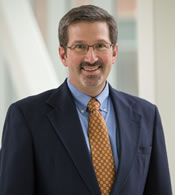Getting Back to Your Life as Usual

~~Kathy Konosky, OTR/L, MS, CLT-LANA, occupational therapy clinical specialist
How physical therapy and occupational therapy during and after cancer treatment can help recovery
When you're diagnosed with cancer, everyone's first priority is doing what they can to get rid of it. You may need surgery. Your oncologist might prescribe chemotherapy or radiation. These things can take a toll on your body, even when the cancer is gone. Whether you're in treatment or done with treatment, what can you do to feel more like your old self?
We spoke to Kathy Konosky and Ron Sayre from the Department of Physical Medicine and Rehabilitation, who perform both occupational therapy and physical therapy in patients with cancer. They discuss the many ways OT and PT can help patients recover from symptoms and side effects of their diseases and treatments. You might be surprised by just how much they can help you accomplish.
Q. Can you define for Thrive readers what physical therapy and occupational therapy are?
Physical therapy aims to maintain, restore and improve movement, activity and health to allow a person to have the best functioning and quality of life. PTs evaluate, diagnose and manage patients who have impairments, activity limitations and restrictions. They promote health, wellness and fitness to reduce risk, slow or stop the progression of functional decline and disability, and enhance a person's quality of life so they can participate in chosen life situations.
Occupational therapy helps people get back to their everyday life activities with the goal to function as well as possible at home, school, work and the community. OTs can evaluate and treat the physical, cognitive, psychosocial, sensory-perceptual and other aspects of a person's performance. The goal is to support and improve engagement or involvement in occupations or activities that affect physical and mental health, well-being and quality of life.
Q. Since there seems to be some overlap, can you help us understand the differences?
Here's an example: A leukemia patient has lymphedema, or chronic swelling, due to radiation treatment she had years ago combined with medication she takes now. She goes to occupational therapy for her lymphedema, which includes treatments like skin care, lymphatic drainage through massage, compression and stretching. The OT also teaches her ways to manage symptoms at home.
The same patient sees a physical therapist because she has graft vs. host disease with symptoms off and on. This leaves her weak and fatigued, especially after a hospital stay. Her PT helps with building strength, primarily of her lower extremities, and developing more endurance. As a result, she has the energy for more day-to-day activities.

Q. When might a cancer patient be prescribed physical therapy and occupational therapy?
We receive a lot of referrals from the Rogel Cancer Center. We can help patients deal with anything that isn't the same as before their illness. Patients often feel like they don't want to complain about things like limited arm movement or a sore back when they have a much bigger battle to wage with their cancer. But we can help address those ongoing symptoms they're dealing with every day and help make daily life better.
Q. How does a cancer patient know when he or she needs physical therapy or occupational therapy?
The most important thing is to be honest with your primary doctor and oncologist about the symptoms you're experiencing. It is not complaining. Just because an issue might not be the biggest issue you’re facing doesn't mean it can't be helped or corrected.
Symptoms a patient may have range from being too tired to function, to specific pain in the body to limited mobility. Patients might experience weakness, problems with coordination, lymphedema or problems with posture resulting from treatment.
Q. What kinds of side effects, specifically, do you improve upon for cancer patients?
There are all sorts of things. Cancer and cancer treatment are hard on a person's body. Lymphedema, for example, is a big issue in cancer patients and the buildup of fluid in a leg can affect things like joint mobility and balance. Scar tissue from surgery sometimes forms and causes pain or reduced movement. Nerve problems from treatments can cause weakness and numbness or tingling in your hands, making it difficult to perform daily tasks.
Then there's the problem of fatigue that affects so many patients with cancer. It can be chronic, which can cause functional problems that cascade into a lot of areas of a person's life. PTs and OTs get at the root of the problems and help patients overcome them.
Ask your doctor whether physical therapy or occupational therapy is right for you based on your symptoms from cancer or treatment.
Q. What can physical therapists and occupational therapists do for patients?
We help patients have more energy, better mobility and less pain. There is also psychosocial recovery in cancer, meaning PTs and OTs can assure patients that their symptoms are normal and can be improved or alleviated. We help patients become fitter and healthier. We're always thinking about how we can incorporate helpful, functional activities in a way they can do as easily as possible.
PTs and OTs want patients to be fully functional. We can educate patients on ways to help them lower the risk of certain problems coming back. For example, lymphedema is a chronic condition that puts people at a higher risk for developing infections. In addition to alleviating the swelling, we can teach people "risk reduction principles," including diet, skin care, stretching and deep breathing. We teach them self-management so they know what to do if symptoms arise in the future.
Q. What about patients who are done with treatment and want to feel better?
One great intervention we have to offer is personal training specifically for cancer survivors in our Cancer Rehabilitation Program. This is part of the University of Michigan's Department of Physical Medicine and Rehabilitation. Physical inactivity can lead to many disabling health issues. People want to feel better after cancer, not worse.
Visit the Cancer Rehabilitation Program webpage to learn more!
Read the Winter, 2014 issue of Thrive
Continue learning about the side effects of chemotherapy
- Poetry Puzzler: Battling Back Chemobrain with Your Pen
- Finding the Right Help: Tips for seeking out complementary therapy providers in your hometown
- Joint Pain: Is it Just the Weather?
- When to Ask for Help
